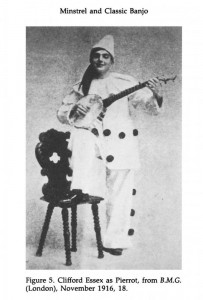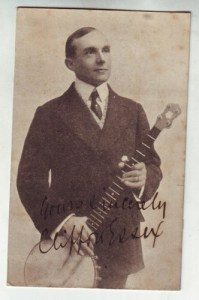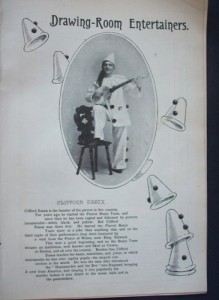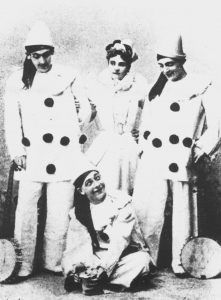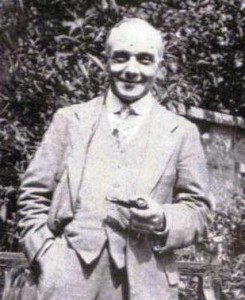Clifford Essex – My Pierrot Hero
I first started exploring the history of pierrots and concert parties when I was an undergraduate at Sussex University – I was astonished to find that this entire history of a British popular entertainment industry, responsible for tens of thousands of performers over 50 years, had all but been expunged from our performance heritage. Having spent three years studying the interplay of social, political and cultural forces pervading Europe and Britain, how could it be that so little was known about the pierrot troupes, whose genesis was only 90 years before my own time? There were no text books on the topic, no training ground, there were just some anecdotal reference books (Geoff Mellor’s Pom-Poms & Ruffles & Bill Pertwee’s Promenades & Pierrots) and a few reminiscence items such as Ashley Sterne’s A Comical History of the Co-Optimists and Clarkson Rose’s Twinkle, but there was no video footage, no gramophone recordings, just countless numbers of faded postcards all dating from the start of the picture postcard history, when a message could be sent on the reverse of a picture, which every troupe used as a marketing & merchandising device.
Where had it all started – why had it all started – who started it all and why was the history so obscure? I have spent the last 30 years researching the form and history in both practice and theory. It was noted in both mellor & Pertwee’s books that Clifford Essex was the man who ‘invented’ pierrots as an entertainment first at Henley Regatta and then at Cowes in the Summer of 1891. The success of the Pierrot Banjo team as they were then known, led to performances for the Prince of Wales at Cowes, which led to them adopting the title of Clifford Essex’s Royal Pierrots and who then performed throughout the land (especially at seasides), with countless imitators, for the next 25 years.
Essex saw a production of L’Enfant Prodigue at The Princess of Wales Theatre in 1891, in which the company performed as a family of pierrots – this provided him with the inspiration of performing as a musical troupe at the up-market Summer events that season, to usurp the usual buskers. Much of the al fresco competition were so-called nigger minstrels, whose burnt-cork faces and grotesque costumes were regarded as tawdry and low-brow, the pierrots, by contrast offered a refined, smart look and the virtuoso skill of both the banjo and strill (portable harmonium) playing were far in excess of anything else on the scene. Essex plundered other acts to feature in his pierrot troupe, so performers such as Joe Morley and Ben Lawes and Will Pepper became members of his troupe at various times.
In 1983, I formed my own troupe – The Pierrotters, to explore the realities of performing as a pierrot on the seafront. I bought my first second-hand banjo with £40 of my 21st birthday money, taught myself 8 chords, spent a weekend sewing white bridal satin and black lycra pom-poms, then busked with my troupe of 5. From such humble beginnings and a spirit of curiosity and the energy and musical ability of a young punk, I began my quest to research the story of pierrots in Britain – an industry that can claim to have been the test-bed of post-war British comedy and the roots of our pop music. Over the ensuing 30 years, my work on pierrots has led to me performing throughout the seasides and theatres of Britain and like my pierrot hero Clifford Essex, to royalty and an invitation to Buckingham Palace. More recently, I have started teaching to universities and popular entertainment specialists & musicologists about the roots of our performing heritage and this year, BBC Radio 4 commissioned me to write a short series on the very beginning’s of Clifford Essex’s career. I have amassed a huge archive of material related to the pierrot industry – the largest, I believe, in existence. One day, I hope to create a national archive and achieve full recognition for the work that started in 1891 by the master, Clifford Essex. Sadly, The Pierrotters are the last-remaining troupe, but maybe it is time for another to be inspired!
Tony Lidington
25th February 2013
If anyone has any information or archive material about Clifford Essex troupe, I would be most anxious to be in touch on info@prom-prom.com

